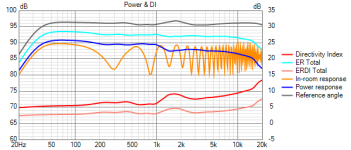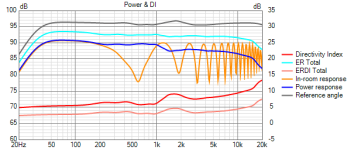Alright, that makes sense. Next , I was going to ask "With so many different wavelengths involved, why care about any of it? " but I guess this part of the design figuring is all about focusing on what is heard at a single listening position. . . . . ?
This is the first time I've heard the term specular reflection. Thank you. (This is fun!)
This is the first time I've heard the term specular reflection. Thank you. (This is fun!)
No, but it does hold a special significance. Once it goes behind you and gets mixed up in the room, the specific modes can become less of a concern than the totals.figuring is all about focusing on what is heard at a single listening position. . . . . ?
"No, but it does hold a special significance."
Because that's where you are planning to do most of your listening? or is there another reason?
Because that's where you are planning to do most of your listening? or is there another reason?
I guess I should have said partly, rather than no. Early reflections can have a different, and possibly lesser significance than the direct sound since they're delayed, but this is less the case at lower frequencies. Most crossover work is done on the speaker without considering the room, but the acoustic design such as this plays a part in it's success.
Fellows, do you think it is feasible to avoid a bass null in the 100 hz to 200 hz range from the bass driver by playing on its heigth on the front baffle?
I remember also Dickason illustrated to put a null around 300 hz by positioning the cabinet close to the front wall and near the side one....
I remember also Dickason illustrated to put a null around 300 hz by positioning the cabinet close to the front wall and near the side one....
Yeah there is six boundaries in a cubicle room, and one first specular reflection from each, a lot of 2nd order reflections could also arrive about at the same time as latest 1st order reflection, and so on. Floor is about the earliest one to arrive as both driver and listener are quite close to it. A sidewall could be very close, or back wall if your sofa is other side of the room. Front wall, the one behind speaker, is surprisingly far away in terms of sound travel, as it is a round trip. Now, depending how all of these combine could make audible suckout.
If you put woofer closer to floor decrease path length difference to direct sound and get interference higher in frequency, then path length through ceiling would increase, so it's a balancing act best handled by speaker positioning.
You could use some tool, like VituixCAD room tab to kind of estimate response of some early reflections. First thing you notice it is impossible to "fix" it, and playing some with it you'll notice that quite many configs work likely just fine, while some configs could have huge null forming, multiple nulls near each other combine. It is good lesson though, so worth trying out.
Height of woofer might matter, if path lengths through walls, for example, are bad and you can do nothing about positioning. I have not enough experience to say some woofer height would be universally better than some else, or something would be bad. I would not worry about it but let other aspects of speaker design to determine it. You likely want tweeter at listening height, and depending how many ways and what the xo points happen to be and so on, the woofer ends up at some height, and I think this is more important than worrying abput floor bounce. You certainly could worry about it, and investigate it as it's fun time with the hobby 🙂
If you put woofer closer to floor decrease path length difference to direct sound and get interference higher in frequency, then path length through ceiling would increase, so it's a balancing act best handled by speaker positioning.
You could use some tool, like VituixCAD room tab to kind of estimate response of some early reflections. First thing you notice it is impossible to "fix" it, and playing some with it you'll notice that quite many configs work likely just fine, while some configs could have huge null forming, multiple nulls near each other combine. It is good lesson though, so worth trying out.
Height of woofer might matter, if path lengths through walls, for example, are bad and you can do nothing about positioning. I have not enough experience to say some woofer height would be universally better than some else, or something would be bad. I would not worry about it but let other aspects of speaker design to determine it. You likely want tweeter at listening height, and depending how many ways and what the xo points happen to be and so on, the woofer ends up at some height, and I think this is more important than worrying abput floor bounce. You certainly could worry about it, and investigate it as it's fun time with the hobby 🙂
One may not be able to completely fix boundary nulls, floor nulls in particular, but woofer height certainly affects them. Vituix is the perfect tool for modeling in search of a good woofer height. This goes back to Allison, who, IIRC, recommended at woofer at floor level playing up to 300 Hz.
I'm modeling a 12" OB coax just above a 15" Uframe woofer. First attachment orange trace is in-room response with floor reflection enabled with floor set 900mm below coax center. This leaves room for a subwoofer below the Uframe. 2nd attachment is with the floor set at 600mm below coax center. Floor null moves up in frequency and doubles in depth. I've played games with multiple drivers overlapped in the floor null region and got even more suppression of the floor null but abandoned those solutions when I realized the suppression in these cases was highly position dependent.
I'm modeling a 12" OB coax just above a 15" Uframe woofer. First attachment orange trace is in-room response with floor reflection enabled with floor set 900mm below coax center. This leaves room for a subwoofer below the Uframe. 2nd attachment is with the floor set at 600mm below coax center. Floor null moves up in frequency and doubles in depth. I've played games with multiple drivers overlapped in the floor null region and got even more suppression of the floor null but abandoned those solutions when I realized the suppression in these cases was highly position dependent.
Attachments
Little addition to this, very often the resolution of either the graph or the measurements (or both) isn't high enough to really show the deep nulls.The nulls can be less sharp because the cone is larger
- Something a lot of people (incl expensive measuring gear) often forget.
Keep in mind that both sources need to be perfectly aligned as well to make this happening.
So being ever so slightly off, is enough to not get a full null.
But anyway, the point here is the pattern of this phenomena. 🙂
I just wanted to bring a bit attention to this, because I often get questions about it 🙂
Try enabling ceiling and the two walls as well, then move the height 😉 Or listening distance. Put the woofer close to floor to push the dip higher in frequency, and now the dip plagues the midrange, which you then also move close to floor?🙂One may not be able to completely fix boundary nulls, floor nulls in particular, but woofer height certainly affects them. Vituix is the perfect tool for modeling in search of a good woofer height. This goes back to Allison, who, IIRC, recommended at woofer at floor level playing up to 300 Hz.
I'm modeling a 12" OB coax just above a 15" Uframe woofer. First attachment orange trace is in-room response with floor reflection enabled with floor set 900mm below coax center. This leaves room for a subwoofer below the Uframe. 2nd attachment is with the floor set at 600mm below coax center. Floor null moves up in frequency and doubles in depth. I've played games with multiple drivers overlapped in the floor null region and got even more suppression of the floor null but abandoned those solutions when I realized the suppression in these cases was highly position dependent.
You could use multiple drivers to reduce sound toward first specular reflection on the floor, or very big waveguide. One could put the woofer close to floor to push the dip to midrange, and then two or more midrange drivers try and reduce sound toward floor.
In case of measurements, people also need to keep an eye on ceiling, wall and back wall bounce!Useful tool : https://mehlau.net/audio/floorbounce/
Especially the last one is very often forgotten.
Since those tools (which are great btw) don't show those, they can be a bit deceiving.
In a sense that you think you got your measurement setup all nice and ready.
But still have a ton of reflections in your results.
Putting your entire measurement setup anti-parallel to the wall(s) could help as just one example.
Last edited:
^ yes. This one take everything into account ( if your room is a typical rectangular one):
http://tripp.com.au/sbir.htm
http://tripp.com.au/sbir.htm
It's not easy. If you are finding it necessary you may want to consider multiple woofers.do you think it is feasible to avoid a bass null in the 100 hz to 200 hz range from the bass driver by playing on its heigth on the front baffle?
Because of room modes, up to roughly 150-250 Hz, this is physically impossible anyway.It's not easy. If you are finding it necessary you may want to consider multiple woofers.
That's why we either want a multi-subwoofer solution and/or acoustic treatment.
The first one is much easier to implement.
Sorry, I don't follow what you're trying to say? 🙂Once the ceiling and floor are working together....
I guess what you mean is that when the distance between floor and ceiling is so big that their won't be any standing waves anymore?
For many European rooms, the average ceiling height is about 2.5 meter.
Which results in a standing wave of around 69Hz (nice), without any additional correction.
The 2nd order would be 138Hz and 4th (there are only even) is 276Hz.
Which is around the transition, that's why I gave a range 😉
For many European rooms, the average ceiling height is about 2.5 meter.
Which results in a standing wave of around 69Hz (nice), without any additional correction.
The 2nd order would be 138Hz and 4th (there are only even) is 276Hz.
Which is around the transition, that's why I gave a range 😉
I like to use REW to determine peaks and nulls due to speaker positioning. I like my 15" woofer close to the floor then I find a good distance to the wall then multiply that by 1.5 to the front wall then hope the distance to the ceiling isn't a multiple to any other dimension.
Distance to side wall = 1.5 distance to floor. Distance to front wall = 1.5 distance to wall. Hope for something good to the ceiling. Use REW to dicker around distances. Set it up and take some measurements.
It's not so easy even with a custom room.
Distance to side wall = 1.5 distance to floor. Distance to front wall = 1.5 distance to wall. Hope for something good to the ceiling. Use REW to dicker around distances. Set it up and take some measurements.
It's not so easy even with a custom room.
- Home
- Loudspeakers
- Multi-Way
- Floor-to-Woofer Coupling for Large Three-Way

